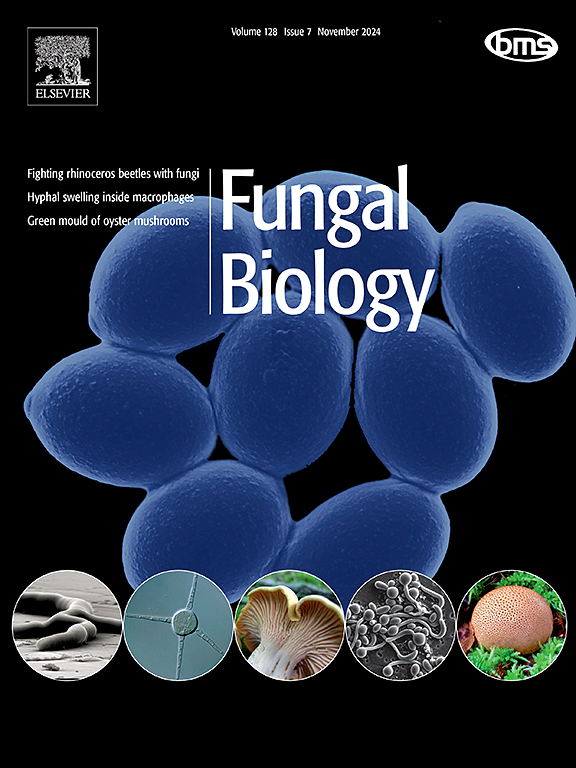Molecular, morphophysiological, and pathogenic characterization of Colletotrichum isolates from strawberry plants in Santa Catarina, Brazil
IF 3
3区 生物学
Q2 MYCOLOGY
引用次数: 0
Abstract
Strawberry (Fragaria × ananassa) holds significant importance within the small fruits group of temperate climates. However, its high susceptibility to diseases, particularly anthracnose caused by Colletotrichum isolates, can severely limit production. This study aimed to identify and characterize Colletotrichum species causing strawberry anthracnose in Santa Catarina state, Brazil. Isolates were collected from strawberry plants exhibiting typical anthracnose symptoms on different plant parts, in both organic and conventional fields. A phylogenetic analysis was conducted using six loci, including actin (ACT), β-tubulin (TUB2), calmodulin (CAL), glyceraldehyde-3-phosphate-dehydrogenase (GAPDH), glutamine synthetase (GS), and nuclear ribosomal internal transcribed spacer (ITS), to identify the Colletotrichum isolates. Morphological and cultural characteristics, including conidia size, shape, and sexual reproductive structures were assessed. Pathogenicity tests were performed on detached leaves, fruits, and whole plants of the cultivars (cvs.) Albion, Pircinque, and San Andreas. Additionally, lipolytic, lipase, and cutinase activities were evaluated. The multilocus phylogenetic analysis identified the isolates as Colletotrichum nymphaeae, Colletotrichum siamense, and Colletotrichum karstii. Six groups of colony color were observed. Colletotrichum siamense and C. karstii predominantly exhibited cylindrical conidia shapes, while most C. nymphaeae isolates were fusiform. Furthermore, the presence of sexual structures, such as asci and ascospores, was exclusively noted in C. karstii. Pathogenicity tests on leaves and fruits showed that all isolates caused leaf spots and fruit rot in the three tested cvs., except for two isolates of C. nymphaeae (M135 and M165), which did not cause leaf spots on the adaxial leaf surface of cultivar (cv.) San Andreas. Whole plant assays indicated that the isolates caused anthracnose symptoms on leaves, petioles, fruits, flowers, and crowns, with the most prominent symptoms on petioles and fruits. Colletotrichum karstii showed a three-fold higher halo diameter (10.2 mm), indicating increased lipolytic activity, while C. nymphaeae (M133) exhibited a twelve-fold higher lipase activity, and C. siamense had a twenty-eight-fold higher cutinase activity compared to controls. These findings provide new insights into the distribution and pathogenicity of Colletotrichum species causing strawberry anthracnose in Santa Catarina. The molecular, morphological, and enzymatic characterizations enhance our understanding of species-specific virulence factors, which can support the development of targeted disease management strategies for strawberry production.
巴西圣卡塔琳娜草莓炭疽菌分离株的分子、形态生理和病原学特征
草莓(Fragaria × ananassa)在温带气候的小水果群中占有重要地位。然而,它对疾病的高度易感性,特别是炭疽菌分离株引起的炭疽病,严重限制了生产。本研究旨在鉴定巴西圣卡塔琳娜州草莓炭疽病的炭疽菌种类。从有机田和常规田草莓植株不同部位表现出典型炭疽病症状的分离株中采集。利用肌动蛋白(ACT)、β-微管蛋白(TUB2)、钙调蛋白(CAL)、甘油醛-3-磷酸脱氢酶(GAPDH)、谷氨酰胺合成酶(GS)和核糖体内转录间隔酶(ITS) 6个基因座进行系统发育分析。形态学和培养特征,包括分生孢子的大小、形状和有性生殖结构进行了评估。对不同品种的离体叶片、果实和整株进行了致病性试验。阿尔比恩,皮尔辛克和圣安德烈亚斯。此外,脂溶酶,脂肪酶和角质酶活性进行了评估。多位点系统发育分析鉴定分离株为少女炭疽菌(Colletotrichum nymphaeae)、siamense炭疽菌(Colletotrichum siamense)和karstii炭疽菌(Colletotrichum)。观察6组菌落颜色。炭疽菌(Colletotrichum siamense)和卡氏炭疽菌(C. karstii)的分生孢子主要呈圆柱形,而若虫菌(C. nymphaeae)的分生孢子大部分呈梭形。此外,性结构的存在,如子囊和子囊孢子,只注意到在C. karstii。叶片和果实的致病性试验表明,所有分离株均可引起3株被试葡萄的叶斑病和果腐病。除两株株(M135和M165)未在品种叶片正面产生叶斑外,其余均未发生叶斑病。圣安德烈亚斯。全株测定结果表明,分离菌株在叶片、叶柄、果实、花和花冠上引起炭疽病症状,其中叶柄和果实的症状最突出。炭疽菌光晕直径(10.2 mm)增加了3倍,表明其脂溶酶活性增加,而C. nymphaeae (M133)的脂肪酶活性增加了12倍,C. siamense的表皮酶活性增加了28倍。这些发现为了解圣卡塔琳娜州草莓炭疽病病原菌的分布和致病性提供了新的认识。分子、形态和酶的特征增强了我们对物种特异性毒力因子的理解,这可以支持草莓生产的靶向疾病管理策略的发展。
本文章由计算机程序翻译,如有差异,请以英文原文为准。
求助全文
约1分钟内获得全文
求助全文
来源期刊

Fungal biology
MYCOLOGY-
CiteScore
5.80
自引率
4.00%
发文量
80
审稿时长
49 days
期刊介绍:
Fungal Biology publishes original contributions in all fields of basic and applied research involving fungi and fungus-like organisms (including oomycetes and slime moulds). Areas of investigation include biodeterioration, biotechnology, cell and developmental biology, ecology, evolution, genetics, geomycology, medical mycology, mutualistic interactions (including lichens and mycorrhizas), physiology, plant pathology, secondary metabolites, and taxonomy and systematics. Submissions on experimental methods are also welcomed. Priority is given to contributions likely to be of interest to a wide international audience.
 求助内容:
求助内容: 应助结果提醒方式:
应助结果提醒方式:


